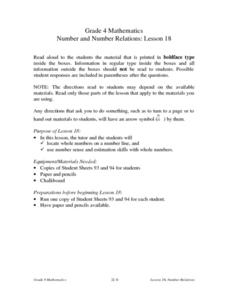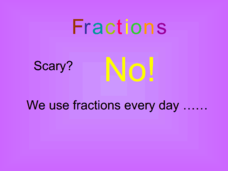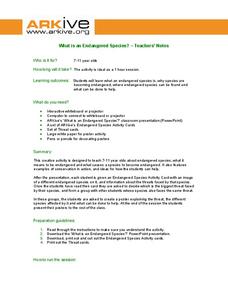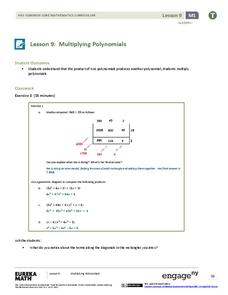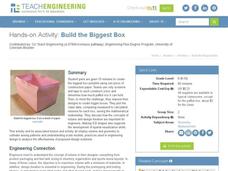Curated OER
Pastry Party!
Everyone gets a toaster pastry to enjoy with this fractions lesson! First, youngsters cut their treat in two, and then they proceed to cut it into equal parts until they have 16 pieces! If your learners aren't quite ready for this...
Curated OER
Bocce Ball Unit - Tournament (Lesson 7)
This is one part (instructional activity 7) of the unit on Bocce ball. There are links on this page to get you to the entire unit. This`instructional activity sets up a tournament of eight teams. You may have to divide your class into a...
Curated OER
Fractions Mean Division
The title says it all: fractions mean division. Explore number sense and operations as you flip from slide to slide, describing how fractions and division are the same thing. Learners will work through a series of problems where they...
Province of Nova Scotia
Fraction Strips
How can you tell how many thirds are in a whole? Or twelfths? Use a fraction strips worksheet to visualize how many parts are in one whole.
Common Core Sheets
Comparing Numerically (Different Denominator)
Compare fractions with different denominators in a handy Common Core based activity. Fourth graders decide which fraction is larger or smaller based on the parts that make up a whole (denominator) and the parts being described...
EngageNY
Our Group Readers Theater: Managing the Sequence of Events in Our Group Script
The whole is greater than the sum of its parts. Working in small groups, class members combine their independent readers theater scripts into part of a larger group script. They complete a storyboard to determine the best sequence for...
Illustrative Mathematics
Pick Two
Learning to break apart numbers into smaller pairs is a critical step young mathematicians take as they develop their number sense. To practice this skill, children are provided with sets of three numbers and are asked to pick the two...
K5 Learning
The Blind Men and the Elephant
Sometimes it's necessary to view the whole picture before making a judgment about a small part. Read a short story about five blind men who try to identify an elephant by feeling different parts and coming to their own conclusions....
Curated OER
Simple Machines III - Pulleys
The principles behind pulleys, levers, and simple machines are the focus of a science instructional activity. In it, learners take part in a whole-class activity. There are two groups of pupils who each must lift objects with fixed...
Curated OER
Number and Number Relations
Upper graders multiply numbers by tens and hundreds, and multiply two and three digit numbers by one digit numbers. They participate in a teacher-led lecture and complete examples with the class, complete a worksheet, and discuss the...
Curated OER
Rhyming Words: The Ut Family
What a great resource! Learners can review words with short vowel sounds, such as bun, bus, and hut using this presentation. The slides are easy to understand and colorful. This would be a quick way to review these words either in a...
Curated OER
Fractions
Fractions are scary for a lot of young mathematicians. This cute presentation tries to take the "scary" out of fractions. The basics are covered: the numerator, the denominator, and the fact that a fraction is a representation of a part...
EngageNY
Revisiting Big Metaphors and Themes: Revising and Beginning to Perform Two-Voice Poems
Now that your class has read all of Esperanza Rising, take the time to tackle big metaphors and themes. Pupils will participate in an activity called Chalk Talk, in which they circulate around the room in small groups and add...
National Center for Case Study Teaching in Science
A Case Study Involving Influenza and the Influenza Vaccine
Using a hypothetical discussion between two coworkers broken up into four parts, budding biologists examine the flu shot and some of the typical arguments for and against it. The conversational nature of the reading makes it engaging and...
Brooklyn Museum
HIDE/SEEK: Difference and Desire in American Portraiture
Visual arts lessons don't always mean the children need to make art. Here, they will practice using their visual literacy skills to analyze four images through the compare and contrast method. The first two images deal with gender...
ARKive
What is an Endangered Species?
Even kids in grades two through five can start thinking about the part they play in sustaining endangered species. They consider what endangered species are, how they become endangered, and what conservationists can do to help. In...
Scholastic
Study Jams! Prime Factorization
Deepen the number sense of young mathematicians by exploring the process of prime factorization. Follow along with this step-by-step presentation that explains how factor trees are used to break a composite number down into its prime...
University of Wisconsin
Designing a Rain Garden
Now it's time for all of the data collected in previous lessons to be applied to the design of a rain garden. This resource can only be used as part of the greater whole, since learners will need to rely on gathered knowledge in order to...
Smarter Balanced
Food Waste and Food Access
Forty percent of food in the US goes uneaten while 14.5 percent of US households lack a secure supply of food. As part of the preparation for a performance task assessment, groups consider statistics such as these about food waste and...
IRISS
Exploring Self-Esteem 1: What Is Self-Esteem?
Adolescents explore self-esteem and the various factors that influence a person's sense of self in this four-part lesson series. Through a combination of whole class instruction, small group discussions, and independent work,...
Super Teacher Worksheets
Improper Fractions & Mixed Numbers
Young mathematicians demonstrate their understanding of part-whole relationships in a fraction skills worksheet. Presented with a series of mixed numbers and improper fractions, learners must correctly convert each of them into...
Willow Tree
Multiplying Polynomials
Make two parts into a whole. Scholars learn to multiply polynomials to create a simplified polynomial expression. Polynomials include monomial, binomials, and trinomials.
Missouri Department of Elementary
The Successful Student: Picturing the Successful Student
Class groups brainstorm the characteristics that make up a successful student before taking part in a whole class discussion. Assigned group roles promote member participation.
Teach Engineering
Build the Biggest Box
Boxing takes on a whole new meaning! The second installment of the three-part series has groups create lidless boxes from construction paper that can hold the most rice. After testing out their constructions, they build a new box....
Other popular searches
- Parts and Wholes
- Parts to Wholes
- Fractions Parts and Wholes
- Math Parts and Wholes
- Fractions Parts of Wholes
- Parts and Wholes Science









